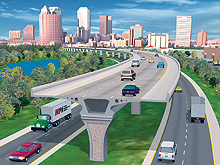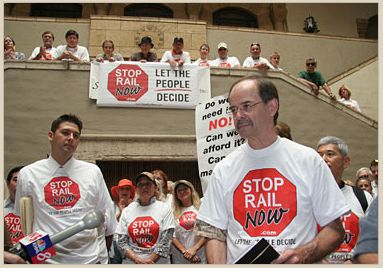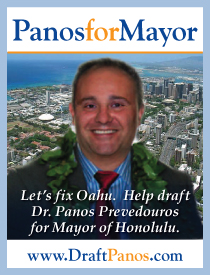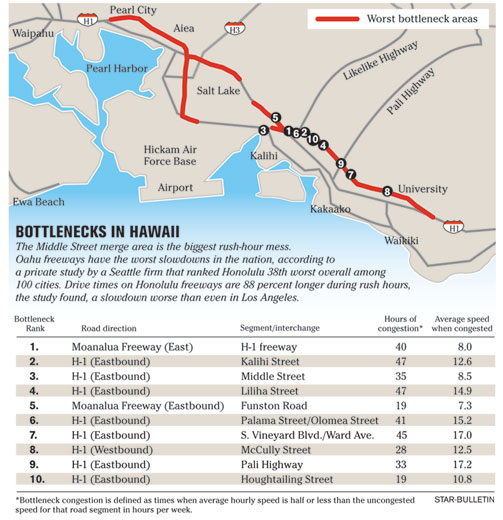
honolulutraffic.com
Offering cost-effective ways to reduce traffic congestion in Honolulu
![]() June 30, 2008.
June 30, 2008.
Changes in federal funding
Here's some interesting comment from a General Accounting Office report recently on the change in federally funded projects, "Since the fiscal year 2001 evaluation and rating cycle, the New Starts pipeline—that is, projects in the preliminary engineering and final design phases—has changed in size and composition, responding to a variety of factors. The number of projects in the New Starts pipeline has decreased by more than one-half, and the types of projects in the pipeline have changed, with bus rapid transit replacing commuter or light rail as the most common type of project. FTA officials attributed the decrease in the number of projects to FTA’s increased scrutiny of applications to help ensure that only the strongest projects enter the pipeline, and to FTA’s efforts to remove projects from the pipeline that were not advancing or did not adequately address identified problems."
![]() June 27, 2008.
June 27, 2008.
Strange happenings at City Hall:
Wherein the Mayor goes off on a rant about a Texas Beauty Queen sent over by oil and chemical interests to destroy the Honolulu rail project. This is something to behold. If anyone knows what the Mayor is up to in this video, please let us know. The Mayor is also running ads of a similar nature.
As for the Mayor's charges; they are baseless. We are not “part of a national effort.” No person from the Mainland is involved in this petition effort. No money has come from the Mainland; the money is raised from T-shirt and bumper sticker sales and from its members and local friends.
As for “conservative,” Dennis Callan, co-chair, is a long-time Progressive Democrat and community activist and if Dr. Michael Uechi, MD, the other co-chair, is a conservative he keeps it well hidden. Neither Cliff Slater nor Dr. Prevedouros have ever belonged to a political party. However, Dale Morita Evans, CEO of Charley’s Taxi, on being sternly asked by the Mayor, “Are you now, or have you ever been, a member of the Republican Party?” bravely did not take the Fifth, but did break under the pressure and admit she had once been, but had since repented.
![]() June 24, 2008.
June 24, 2008.
Two items of interest at Thursday's City Transportation Committee
The City Council Transportation Committee Agenda for this Thursday has two items that we should pay attention to. In particular, we should object to the form of congestion pricing they are referring to. This is the cordon pricing scheme now in use in London and proposed for New York. These are not variably priced by time of day and do not limit driving once inside the cordon. It is merely a new tax in user fee disguise.
. RESOLUTION 08-149 – SUPPORTING CITY INVOLVEMENT IN A STUDY ON THE STATE OF INFRASTRUCTURE IN HAWAII.Expressing the Council’s support for city involvement in a study on “The State of Infrastructure in Hawaii.”
RESOLUTION 07-258 – URGING THE DEPARTMENT OF TRANSPORTATION SERVICES TO DETERMINE THE FEASIBILITY OF IMPLEMENTING CONGESTION PRICING IN HONOLULU. Urging the Department of Transportation Services to study the use of congestion pricing in London, England and the proposed plan for congestion pricing in New York City to determine the feasibility of implementing congestion pricing in Honolulu.
![]() June 22, 2008.
June 22, 2008.

It’s the campaign contributions, stupid!
The Mayor is intent on undermining the citizens’ effort to enable a vote on the rail transit proposal. He has blatantly said that he will do everything possible to kill this effort.
His latest effort is a smear against citizens who only want to give the voters a voice on this multi-billion dollar rail. He is trying to divert attention away from “follow the money.” Rail is not about transportation; it is about campaign contributions.
The Mayor is trying to portray a conspiracy among those opposed to his rail proposal. However, he really knows better. He knows that the opposition is coming from ordinary folks who are totally upset by the idea of spending $5 billion or more on a project, the net result of which will be traffic congestion far worse than it is today.
Anyone who saw the Stop Rail Now folks at the initial press conference on April 21st will remember them as just a total cross section of the community. The co-chairs are Dr. Michael Uechi, MD, and Dennis Callan, President of the Hawaii Geographic Society, two citizens outraged by this waste of taxpayers’ money.
The Mayor really knows that none of the anti-rail people get money from the oil companies, or from any “special interests.” He keeps mentioning taxi companies but the fact is that taxi companies would benefit from rail transit. Since rail rarely takes you exactly where you want to go you need transportation to get there and the quickest way is to take a taxi.
ALL the money that Stop Rail Now gets is from the sale of T-shirts and from its members. Even so, it has spent a tiny fraction of the vast amount of money being spent by the City, its contractors and the unions in trying to push this rail project down the throats of Oahu voters.
Voters must remember that rail transit development is all done by non-bid contractors. On the other hand, HOT lanes are simply highways; the HOT lanes approach is how they are operated. Accordingly, once designed they are put out to bid and there is little spare money to go for campaign contributions.
![]() June 21, 2008.
June 21, 2008.
Wendell Cox puts transit in perspective:
Cox's Demographia website, www.demographia.com is rated by National Journal as one of the four best transportation sites in the nation.
In this particular analysis he uses FHWA data to demonstrate that all the recent brouhaha about gas prices moving people to transit does not really affect traffic as you may have noticed.
|
ESTIMATED DIVERSION OF ROADWAY TRAFFIC TO TRANSIT |
|||||
| 2008: Quarter 1 | 2007 | 2008 | Change | ||
| In billions of passenger miles | |||||
| Transit | 13.04 | 13.47 | 0.43 | ||
| Urban Roadways | 753.33 | 737.98 | -15.35 | ||
| Total Urban Travel | 766.36 | 751.44 | -14.92 | ||
| Transit Market Share | 1.70% | 1.80% | |||
| Estimated share of roadway demand | |||||
| transferred to transit | 2.80% | ||||
| Sources: Transit passenger miles estimated using 2006 FTA average trip length | |||||
| 2007 to 2008 transit ridership change from American Public Transportation | |||||
| Association | |||||
| 2007 to 2008 urban roadway data from FHWA http://www.fhwa.dot.gov/ohim/tvtw/ | |||||
| 08martvt/08martvt.xls and assumes a 1.6 vehicle occupancy rate (from Nationwide | |||||
| Housing & Transportation Survey) | |||||
![]() June 19, 2008.
June 19, 2008.

A Draft Panos campaign is underway:
Dr. Panos Prevedouros is Professor of Civil and Environmental Engineering at
the University of Hawaii.
He’s the perfect mayoral choice because Oahu’s problems are virtually all civil engineering problems. Consider our terrible traffic congestion, aging sewers,
deteriorating water pipes, dilapidated bridges and highways and potholes abound.
Panos has the expertise and experience to deal with these problems as an engineer, not a politician. He would follow in the shoes of another engineer, the
highly successful three-time Honolulu Mayor Johnny Wilson.
Honolulu is a city that is falling apart in front of our eyes.
Right now, we have a politician at city hall who enjoys shaking constituents’ hands and being seen at public events. But what has he really done for the people of Oahu over the last four years?
- The sewer lines and water mains are is a very poor state and there is a billion dollar backlog in replacements and maintenance.
- Honolulu pavements are among the worst in the nation and all the current administrator does is patch them.
- Honolulu is threatened with huge penalties by the EPA and retrofit bills for all its wastewater treatment plans, which do not include secondary treatment.
- Honolulu's solid waste management is simply mismanagement and postponement.
- Bridges, culverts and other infrastructure need regular inspections, maintenance and in many cases, replacement.
- Waianae needs a bypass road. Leeward Oahu needs roadways.
- Traffic congestion is stifling our economy and life style. Honolulu has too many bottlenecks and uncoordinated traffic lights.
Visit the website www.draftpanos.com today and see if we can persuade Panos to run for Mayor of our city.
Monday's rail battle on Rick Hamada now on podcast
Last Monday for the 7-8 AM segment of the Rick Hamada Show on KHVH 830 AM, Gary Okino and Maeda Timson took on Honolulutraffic.com's Cliff Slater and Stop Rail Now's Eric Ryan on the rail transit issue. It was podcast and is now online. If you want to see a clear difference in the thinking between the two sides on this debate, we suggest you listen to the podcast. It is an eye opener.
![]() June 18, 2008.
June 18, 2008.
Star-Bulletin: "Honolulu’s traffic among worst in U.S.":
 Today's Star-Bulletin story is from Seattle-based INRIX, a major supplier of real time traffic information. It says: "If you happen to be
driving on a Thursday from 5 p.m. to 6 p.m. on [Honolulu's] main highways, you're no longer in the Aloha State," according to the report compiled by INRIX. "You're in the worst place and worst hour of any single roadway in the U.S., taking 88 percent more time to get where you're going than if there were no congestion."
Today's Star-Bulletin story is from Seattle-based INRIX, a major supplier of real time traffic information. It says: "If you happen to be
driving on a Thursday from 5 p.m. to 6 p.m. on [Honolulu's] main highways, you're no longer in the Aloha State," according to the report compiled by INRIX. "You're in the worst place and worst hour of any single roadway in the U.S., taking 88 percent more time to get where you're going than if there were no congestion."
They also said, "Honolulu also has two of the 100 worst bottleneck areas in the country. Ranked 41st are the eastbound Moanalua Freeway lanes by the H-1 freeway interchange, with an average congested speed of 8 mph. And ranked 87th are the eastbound H-1 lanes by Kalihi Street, with an average congested speed of 12.6 mph. Those spots are the worst and second-worst bottleneck areas in Honolulu. The third-worst bottleneck, and the 104th in the nation, is the H-1 freeway eastbound near Middle Street."
INRIX gets its data differently than any other survey of the nation's traffic congestion. It tracks a variety of in-vehicle GPS equipment and can thereby determine average and specific delays that would appear to be more accurate than any other method.
Of course, the reaction to this from the political establishment will be all the more reason to build rail transit. Why they don't want to understand that we have a highway traffic congestion problem that can only be solved by increasing highway capacity is beyond us.
Let's put transit ridership increases in perspective:
As one would expect, Honolulu's bus ridership is up a few percent with consumers hurting from the effects of higher gas prices. Nationally, it is the same. With gas prices up, but bus ticket prices remaining the same as in 2003, one should expect that bus ridership would be up.
However, if we review what happened in the 1970s when gas prices also doubled in real terms, we find that by the end of the decade commuter use of transit had declined both as a percentage and in total. People drove less and bought smaller cars.
Gasoline usage increased for a few years until the smaller, more energy-efficient automobiles worked through the system and peaked in 1978. For the next few years U.S. gasoline usage declined by 14 percent until oil prices dropped, gasoline became considerably cheaper and drivers used more of it.
Here are two interesting quotes from this period: "The first myth was that the demand for energy would continue to grow ... The second myth was that energy prices ... would continue to increase ... The third myth was that we were running out of oil."
"... an amazing consensus ... on crucial but mistaken assumptions. The consensus made the mistakes much harder to see for what they were. The consumer joined government and industry in accepting the assumptions that we were running out of oil, that prices would spiral ever upward, that we needed to conserve for virtue's sake, that economic growth marched lockstep with energy use, and that government needed to see to it that we got the synfuels and renewable energy sources that we needed." Lee, Thomas H., Ball, Ben C. Jr. & Tabors, Richard D. Energy Aftermath. Harvard Business School Press. 1990. pp. 20 & 39.
![]() June 17, 2008.
June 17, 2008.
Honda rolls out new zero-emission car
This news of a zero-emission automobile is likely to send the anti-auto crowd into a total tizzy as will the coming introduction of Hyundai i30 diesel (already in Europe) that gets 60 mpg and has very low emissions. All this on top of the news of inroads being made by hybrids and plug-ins must be most disheartening. After all, what the anti-auto people do not like about cars is that they are for individuals instead of the "masses." With cars having less emissions and less energy use per passenger mile what are going to be their new arguments against the auto?
HOT lanes will be like school's out all year:
When summer comes university students, private school students and the myriad public school students with (actual or faked) geographic exemptions all leave the highway. When this 20 percent of the traffic leaves H-1, traffic congestion virtually disappears.
We could experience the same traffic relief year round were we to increase H-1 highway capacity by 25 percent. This would give us the same ratio of cars to road space we experience on H-1 during the summer vacations.
HOT lanes will provide this 25 percent.
Since H-1 only has seven lanes, any two-lane addition would make a distinct difference. However, the two lanes of the HOT lanes will carry twice the traffic that two of the H-1 regular lanes because the managed HOT lanes traffic will be completely uncongested. And full but uncongested freeway lanes carry twice the number of cars that congested freeway lanes can. Therefore, the effect of the two-lane HOT lanes will be as if we had added four lanes to H-1.
HOT lanes will effectively add far more than 25 percent to the Leeward Corridor highway capacity and motorists will experience summertime in winter.
![]() June 15, 2008.
June 15, 2008.
Abercrombie lies about Stop Rail Now:
In an outrageous statement to KITV yesterday, Rep. Neil Abercrombie said that "by signing the petition, people are killing any chance of a mass transit system for Honolulu."
That is an appalling lie unworthy of any member of Congress. The fact of the matter is that the Stop Rail Now effort only puts the issue of rail transit on the ballot so that Oahu voters can vote on it. Many signers of the petition are pro-rail supporters who still believe their support for democracy trumps their rail support. Congressman Abercrombie obviously does not.
The only reason to not sign the petition is if you believe that there is a chance that the vote would go against rail and you don't believe the majority should decide — in other words, you do not believe in the democratic process.
Stop Rail Now's Eric Ryan put the matter in perspective in rebutting Abercrombie on KITV. He said that the federal contribution for rail pales in comparison to the local contribution which is five times that of the federal. There may be a time and place to max out our credit cards but this is not it.
We are the only jurisdiction in the U.S. where the people do not get to vote on projects of this magnitude; our legislators do not appear to support the people having their say in such important issues. Chief among those is Abercrombie.
![]() June 14, 2008.
June 14, 2008.
Stunning: Contra Costa Times editorializes against rail:
Under the headline "Boondoggle Express," the Contra Costa Times wrote the following on Thursday:
"California faces a huge budget shortfall, a weakening economy, a home foreclosure mess, a drought and the need to expand its reservoir system. Tax increases loom even as businesses are down-sizing and inflation threatens a comeback.
"Amid all these challenges, California voters will be asked to approve $10 billion in bonds in November to open the way for the Boondoggle Express. It's a high-speed, high-hopes rail line from San Francisco to Los Angeles that is short on planning and long on fantasy.
"Of course, $10 billion is only the beginning. Another $23 billion will be sought from a deficit-ridden federal government and private investors wary of a recession. The cost of the high-speed train is estimated at $33 billion for the main line, with an additional $7 billion for spur lines to Sacramento and San Diego.
"Does anyone who has followed the saga of the Bay Bridge debacle really believe the high-speed rail system will cost less than $60 billion, $80 billion?"
THOUGHT FOR THE DAY: One would think that given the state of our visitor industry, our chief source of income, that our elected officials would be having second thoughts about vast expenditures such as the rail line. If they are we have not seen any sign of it. Tax revenues are subsiding, our population on the island is declining but it does not seem to bother them.
![]() June 5, 2008.
June 5, 2008.
Great coverage of Stop Rail Now volunteers on Channel 8:
As part of their story on Rail Ads Stir Questions of City's Use of Tax Dollars, Channel 8 had the following on Tuesday,
"Djou has crafted a bill that would require the city to attach a disclosure for city-funded newspaper, radio or TV ads. It's a move anti-rail protesters applaud.
"The city should not be involved in the kind of propaganda they're putting on. They should be informing the public, the information they pass out should be balanced. There is no excuse," said Cliff Slater, an anti-rail protester.
"Stop Rail Now says it funds all of its anti-rail material using private donations. The group says the city should do the same. Mayor Mufi Hannemann's administration was not available on Tuesday for comment."
As part of the story, make sure you see the video of Stop Rail Now volunteers manning the phones, fulfilling requests for petitions,etc.
![]() June 3, 2008.
June 3, 2008.
Misunderstanding the BRT aspect of the HOT BRT proposal:
From the beginning our HOT lanes proposal has advocated that express buses and vanpools have priority and go free of charge while all others would pay a toll such that all HOT lanes vehicles would have uncongested travel. In an effort to make this point we have begun to term it the HOT BRT Alternative. There is no change at all in the policies we advocate, merely the term for it.
Much of the criticism of the HOT BRT Alternative totally ignores the BRT element — most of it deliberately. However, Express buses on HOT lanes will offer commuters a far swifter commute than will rail. Not only will the buses travel faster on the HOT lanes, there is a far greater chance that commuters will be able to make a no-transfer journey by bus. On the other hand, the rail will almost certainly require some kind of transfer and since this is a major deterrent to using public transportation, this aspect of it is likely to benefit Express bus travel.
![]() June 1, 2008.
June 1, 2008.
The other costs of being railroaded:
Read the today’s Advertiser story “189 Hawaii properties in transit's path” carefully. In particular, pay attention to the following section:
“One of the main reasons for starting construction on the 'Ewa end is to avoid right-of-way acquisition issues during the project's early stages, according to Jim Van Epps, project manager for Parsons Brinckerhoff, which is the city's largest transit contractor.”
“In the 'Ewa area, "the parcels are available or should be readily available to us to get the construction going easy," Van Epps said during a recent city-sponsored radio show. "We're not dealing with a lot of residential and commercial areas that are side by side by side that are going to take so many years for us to acquire in order to get the length of property that we need."
What is going on here rests on the fact that large public works projects, once begun, are always finished. This is because most voters are not businesspeople and do not understand the concept of not throwing good money after bad. Thus, if the Mayor is allowed to construct any part of his Kapolei to Waipahu “Shoppers’ Special” rail line and spends, say, $1 billion to do so, the rest of the $6 billion “locally preferred alternative” rail line out to UH and Waikiki will get built. Otherwise, the voters will say, the money spent will be wasted.
Accordingly, the Mayor proposes taking the path of least resistance by building the initial segment out in open fields where there will be no objection to it. After the first section is built, it will be easy to bludgeon into submission those property owners who will be in his way in subsequent sections of the rail line.
The public is going to be affected by this property acquisition program in three ways. First, the $millions to be laid out for these properties and their relocation costs will have to be paid for with taxpayer’s money. Second, the businesses' increased costs will be passed along to consumers. Third, when thriving businesses are condemned it means less competition in their field, which will lead to increased prices to consumers.